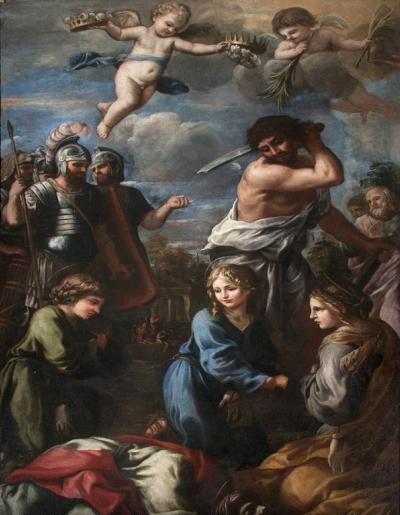
Saint of the Day for 19 January: Saints Marius, Martha, Abacus and Audiface
Saints Marius, Martha, Abacus and Audiface: Heroes of the Ancient Christian Faith
Name
Saints Marius, Martha, Abacus and Audiface
Title
Martyrs in Rome
Recurrence
19 January
Martyrology
2004 edition
Roman Martyrology
In Rome, on the Via Cornélia, the holy martyrs Màrio and Marta married, and their sons Audiface and Abacum, Persian nobles, who, in the time of Prince Claudius, had come to Rome to pray. Of them Martha, after enduring scourges, eculeum, fire, iron hooks and the cutting off of hands, was killed at Nymph; the others were beheaded and their bodies burned.
The Saint and Mission
Saints Marius, Martha, Abacus and Audiface represent emblematic figures in the landscape of early Christianity, embodying a mission of faith and courage that still resonates today. Their story, marked by martyrdom, is a powerful testimony of dedication and sacrifice. These saints, united in their common faith, faced extreme trials with an inner strength and conviction that inspire deeply. Their mission was not only to witness to their faith through martyrdom, but also to live daily according to Christian principles in an age of uncertainty and persecution. Their example of solidarity, mutual support and unconditional love shows how faith can not only sustain the individual in adversity, but also create a strong and cohesive community. In Mario, Martha, Abaco and Audiface we see the essence of the Christian mission: to live and, if necessary, die for one’s principles, always keeping love and compassion at the center of every action. Their story is a warning and an inspiration, a reminder of the strength that comes from shared faith and dedication to an ideal greater than oneself.
The Saint and Mercy
The story of Saints Marius, Martha, Abacus and Audiface is steeped in profound mercy, an element that emerges clearly from their lives and martyrdom. Together, these historical figures embody the essence of Christian mercy, showing how love and compassion can be exercised even in the most difficult circumstances. Their story tells us of individuals who extended their mercy not only to loved ones but also to strangers, demonstrating a generosity of spirit and commitment to the service of others that transcends the barriers of fear and persecution. At a time when loyalty to one’s principles could cost one’s life, Mario, Marta, Abaco and Audiface chose to remain faithful to their mission of love and service. Their mercy manifested itself in acts of kindness and words of comfort, offering a beacon of hope to those in need. Their ability to forgive and show compassion even in the face of suffering and death is a powerful example of how mercy can transcend external circumstances and take root in the deepest of human values. Their legacy teaches us that mercy is not just an act of benevolence, but a way of life that is rooted in acceptance, understanding and unconditional love for one’s neighbor, regardless of challenges and adversity.
Hagiography
The story goes that Marius and his wife Martha of Persian descent were on their way to Rome with their two sons Audiface and Abacus to venerate the relics of the martyrs, as the early Christians used to do. Arriving in the city during the period of the great persecutions ordered by Diocletian, they are said to have helped the priest John bury two hundred and sixty-seven martyrs who had been beheaded and abandoned in the open countryside along the Via Salaria. Discovered, they were arrested, taken to court and…
